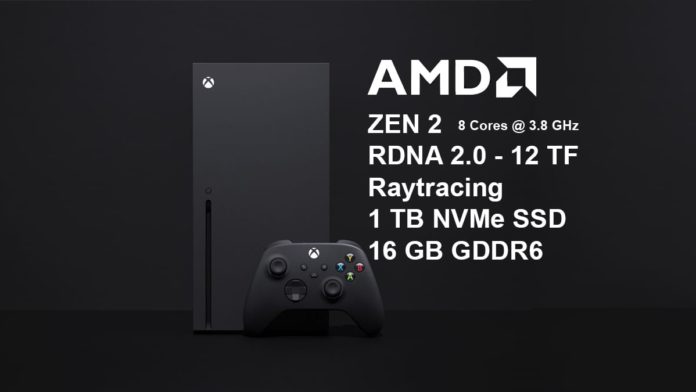Microsoft has now revealed the full specifications of their upcoming next-gen console – the Xbox Series X. While we recently saw them tell us a little bit about what’s under the hood, now we have more details, as revealed in their official blog post. It also reveals more about why the console is built like a PC.
Xbox Series X full specifications:
| CPU | 8x Cores @ 3.8 GHz (3.66 GHz w/ SMT) Custom Zen 2 CPU |
| GPU | 12 TFLOPS, 52 CUs @ 1.825 GHz (Custom RDNA 2) with raytracing |
| Memory | 16 GB GDDR6 w/ 320mb bus |
| Memory bandwidth | 10GB @ 560 GB/s, 6GB @ 336 GB/s |
| Internal Storage | 1 TB Custom NVME SSD |

Now that is some seriously powerful hardware being used in the console. The AMD RDNA 2 powered GPU, which uses Navi architecture, is about as powerful as an RTX 2080! We recently compared the RTX 2060 Super to the Xbox One X, and the results were pretty surprising. If Microsoft can deliver on that PC-like performance promise again, then I actually might consider getting a Series X over building a gaming PC.
While the Xbox Series X will deliver a massive increase in GPU performance and continue to redefine and advance the state of art in graphics with new capabilities such as hardware accelerated raytracing. We don’t believe this generation will be defined by graphics or resolution alone.
Jason Ronald, Director of Product Management on Xbox Series X
The blog also revealed that the performance target for games next-gen will be 4K at 60 FPS, Up to 120 FPS. Do note that the 120 FPS doesn’t refer to a higher resolution like 4K, but probably 1080p or 1440p. Aside from an NVMe SSD, the storage can also be upgraded with an expansion card, with support for playing gamers off of USB 3.2 hard drives.
Microsoft invited YouTube Austin Evans as well as Digital Foundry to take a deep dive and provide first impressions on the console.
In addition to these new specs, Microsoft also revealed that the Xbox Series X will have new and improved ways of handling controller lag. As shown in the infographic below, the Series X will use technologies like Dynamic Latency Input (DLI) and take advantage of HDMI 2.1, which supports 8K output and 120Hz refresh rates at lower resolutions.
Competitive gamers and the best gaming experiences demand precise, responsive controls. The Xbox team analyzed the entire end to end input pipeline, from the controller to the console and from the console to the display and we challenged ourselves to identify every opportunity to further reduce latency to provide the best experience for gamers on Xbox.
Andrew Goossen

The next Xbox will use what Microsoft is calling ‘Xbox Velocity Architecture’, which consists of four components: custom NVMe SSD, a dedicated hardware decompression block, an all-new DirectStorage API, and Sampler Feedback Streaming (SFS). This will allow developers to improve asset streaming and effectively multiply available memory.
Aside from the technical aspects, some gameplay was also revealed. These include Gears 5 and Minecraft with raytracing. It’s notable that no next-gen gaming was shown off as none have even been announced yet (except for Halo: Infinite). Load times have also drastically been reduced thanks to that SSD, which Microsoft showed off in a tech demo. Compared to the Xbox One X, currently the most powerful console in the market, the Series X was significantly faster. The ‘Quick Resume’ feature, which lets you suspend and resume multiple games, was also shown off as can be seen in this video:
The Xbox Series X full specifications reveal has us very interested in what boundaries next-gen gaming will push. The console comes out sometime during the Holiday season of 2020 (read around or after November).


